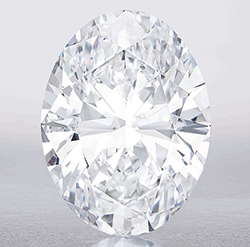Company Profiles
Get Ready For More Assets To Be "Financialised"

Diamonds are becoming “financialised.” They are far more
investable than before, creating inflows and boosting liquidity,
the founder of a tech-driven business has told this
publication.
Last week, Diamond Standard,
which has developed a “diamond commodity” investment offering,
closed a
$30 million investment round. The round was led by Left Lane
Capital and Horizon Kinetics. Additional participants include
Gaingels and Republic.co.
The fundraising programme came after the group launched the
Diamond Standard Fund, enabling investors to allocate to diamonds
through shares, rather than holding physical diamonds directly.
In the past, the specific qualities of diamonds – every one of
them is different – has tended to make it hard to treat them as
an homogenous asset class, such as gold. Diamond Standard is
using technology from the cryptocurrency and blockchain space to
drive development.
At the core of the firm’s approach is bringing previously
hard-to-enter asset classes closer to the mainstream. And that
chimes with the rise of “tokenization” of asset classes such as
venture capital, private equity and forms of real estate. (See
articles
here and
here for more on the trends.)
Cormac Kinney, founder of The Diamond Standard, uses the term
“financialisation” to describe what, to some extent, his business
is all about.
“Diamonds are getting financialised and that is driving up their
price,” Kinney told this news service.
And it is not just diamonds that could could be treated in this
way. Kinney noted that the Uranium market has become much more
“financialised” in recent years, as with the rise of
uranium-linked exchange-traded funds.
There are possible uses in areas such as carbon credits
and forms of real estate. “We have been approached by a
number of companies,” Kinney continued.
The Diamond Standard might hold part of the solution to the
problems that have hit the stablecoin market this year, when
prices slumped dramatically and, in some cases, were wiped out.
“There are a lot of uses of diamonds – as a store of wealth, as a
hedge and all the vectors that drive diamond demand,” Kinney
said.
The business has been through rapid change – even the
two-year pandemic didn't prove much of a barrier.
In September 2021, the firm announced that it had new
headquarters on Fifth Avenue, New York, overlooking the
city’s diamond district and near the Gemological Institute of
America. Last year it also announced that agreements were in
place to develop diamond futures offered by MGEX™ via the CME
Globex® platform, and options via MIAX™.
The above-mentioned Diamond Standard Fund is approved by the
Bermuda Monetary Authority (achieving reciprocity with the
Securities and Exchange Commission). It invests in fungible
diamonds via standardised coins and bars and is targeting an
initial capacity of $500 million working with wealth managers,
high net worth investors, family offices, IRA platforms, and
institutional investors.
How does the Diamond Standard work?
The firm’s process produces “coins” and “bars” composed in such a
way that they reflect the proportions of diamonds’ defining
qualities (carat, cut, etc) across the entire diamond market as
found in the earth. This creates a standardised measure of such
qualities – allowing a fungible commodity to develop, which
can then be tokenized via blockchain distributed ledger
technology. The fungible sets of diamonds are sealed in
transparent resin – to create the Diamond Standard Coin or
Diamond Standard Bar – containing a military grade wireless
encryption chip.
Custodians store the commodity in smart cabinets, which audit
them constantly, enabling owners to transact them remotely
using the “Bitcarbon” token. The owner alone has the digital key.
For every transaction, the encryption chip is challenged by the
blockchain in a process called "proof-of-asset.” When the
commodity is held by the owner it can be authenticated and sold
using a smartphone anywhere in the world.
Potential
The size of the market for such a modern diamond market is large,
Kinney argues. So far, only 1 to 2 per cent out of a total size
of $1.2 trillion of gem-quality diamonds are owned by
investors. Diamond Standard wants to propel this figure to
15 per cent in the next five years, spurred by a deep array of
potential vehicles – including an ETF, fractional exposure to its
coins and bars, futures, and options contracts, and a UCITS
vehicle.
The development of this investment entity is important in markets
such as the US because advisors such as RIAs are required to
hold listed shares/securities.
Understanding this sphere is not easy. Kinney said that a lot of
what the Diamond Standard does is about educating clients and
advisors.
Diamond prices, which have risen since January this year, rose
about 40 per cent in 2021. They are often uncorrelated to other
assets, he continued.
Diamonds have been relatively ignored compared with some other
commodities due to bad publicity about “blood diamonds” or
“conflict diamonds,” but the vast majority of them don’t
come from Sierra Leone, but conflict-free countries, Kinney said,
adding that DeBeers no longer dominates the space.
“It is a great contrarian investment,” he said. Interest is
coming from hedge funds, family offices and high net worth
investors. Some RIAs have added diamonds to certain
portfolios and it provides an inflation hedge.
WB asked what the ETF is going to be called and about
the likely launch date.
“We will likely call it `Diamond Standard Trust’, and the NYSE
has reserved the ticker DIAM. We have been approached by a large
ETF sponsor, so they would add their name to the front,” Kinney
said.
“We hope to launch the listed fund in early 2023, and I can
imagine an ETF being approved perhaps late 2024 at the earliest.
The constraint is that we need a large volume of spot or futures
trading on a `national market’ such as CME.
